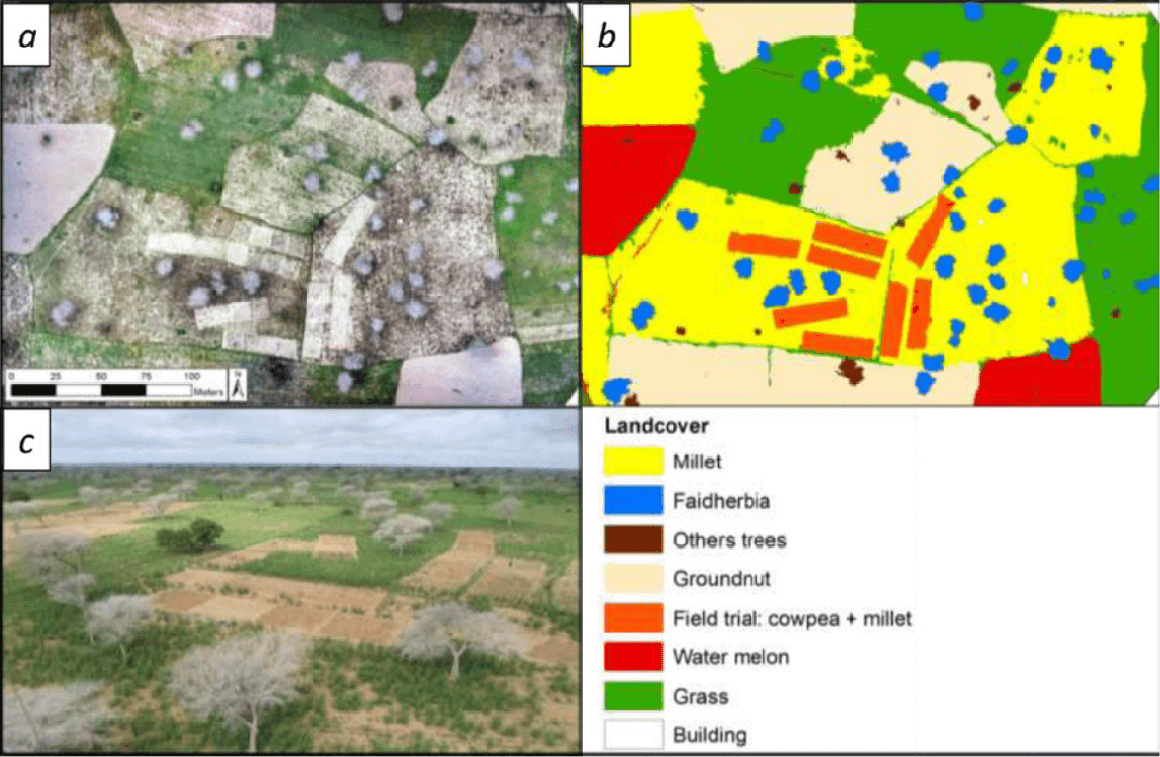- Home
- Worldwide
- CIRAD worldwide
- Projects
- Projet RAMSESII
Roles of agroforestry in the sustainable intensification of small farms and food security for societies in West Africa - RAMSESII

Niakhar agroforestry parkland (Senegal) seen from a drone in the wet season, where defoliated Faidherbia trees (white tops) dominate (a) and land occupation map with a mosaic of substratum crops obtained by remote sensing: millet, groundnut, cowpea, watermelon and grassy fallow (b). View of the landscape from the flux tower measuring gases in the ecosystem (30 m high) in the rainy season (c). © Cirad
Issues
In a context of reduced arable land, the intensification of conventional agriculture seems to be a rapid and effective solution. It maximizes yields in the short term and satisfies the surge in food requirements. However, it entails high long-term risks (drop in seed fertility and diversity, disrupted water cycles). On the other hand, agroforestry, by enabling the production of a larger quantity and diversity of products, helps to secure incomes whilst providing supporting and regulating ecosystem services. The latter are a starting point for designing more resilient and climate-smart agricultural systems.
RAMSESII seeks to direct practices towards an intensification of agroforestry, by proposing new participatory parkland management methods.
Description
RAMSESII adopts a holistic, transdisciplinary and multi-scale approach to assess and take into account parkland management factors based on six approaches:
1. Collaboration between researchers in the social sciences, foresters, agronomists, geographers, biophysicists, and remote-sensing experts working with farmers and other agroforestry stakeholders in West African agroforestry, and sharing of scientific and endogenous knowledge;
2. Analysis of farmers’ priorities, attitudes, skills and assets, to adopt intensification methods based on scientific and local evidence;
3. Assessment of the impacts of these intensification methods on farm incomes and ecosystem services, focusing on provisioning as a priority for food security;
4. Characterization of the stakeholders, governance frameworks, institutional arrangements and policies impacting parkland management;
5. Co-building with stakeholders of realistic scenarios of land tenure and governance that enable farmers to sustainably intensify parklands;
6. Development of a framework to monitor and assess project impacts.
Four types of parklands, in Senegal and Burkina Faso, are being studied:
1. The Faidherbia parkland (Faidherbia albida, nitrogen-fixing tree) at Niakhar, Senegal;
2. The Guiera parkland (Guiera senegalensis) at Thiès-Keur Matar, Senegal;
3. The shea parkland (Vitellaria paradoxa) near Koumbia, in Burkina Faso;
4. The Piliostigma parkland (Piliostigma spp., nitrogen-fixing bush) at Kamboinsé-Yilou, Burkina Faso.
Expected impacts
- The roles played by agroforestry in the intensification of small farms and food security in West African societies will be characterized. Knowledge will have been disseminated among the local populations, who agree on the importance of intensifying agroforestry practices;
- New management methods for agroforestry parklands will see the light of day, moving towards sustainable intensification;
- Food security in the region is improved. Farmers’ incomes increase, as does the resilience of the parklands and crops faced with climate change.
























